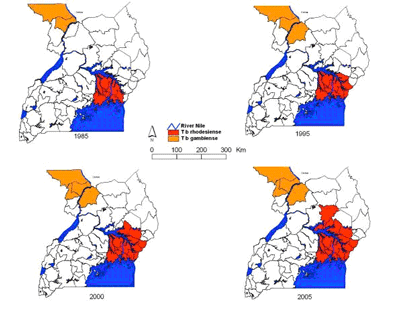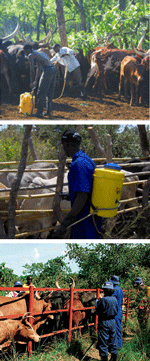STAMP OUT SLEEPING SICKNESS
|
|
Introduction to the stamp out sleeping sickness project
Background to sleeping sickness in Uganda
The spread of sleeping sickness in Uganda
Communication of research to communities and policy makers
|
Spread of sleeping sickness in UgandaThis image below shows the convergence of the two strains of the parasite, with the orange area representing the endemic area for chronic form, T. b. gambiense, in the north west of Uganda, near the Sudanese border; the red represents the acute form, T. b. rhodesiense, initially confined to the south east of the country, and now spreading north (as shown on the image above). Scientists are concerned that the primary reason for this spread is the movement of cattle, with farms being restocked, in an attempt by the Ugandan government to stimulate livestock production. In the past 5 years the disease has spread to 5 new districts. 
Maps showing the convergence of T.b. rhodesiense and T.b. gambiense in Uganda Picozzi K, Fèvre E, Odiit M, Carrington M, Eisler M, Maudlin I, Welburn S. (2005) Sleeping sickness in Uganda: a thin line between two fatal diseases, BMJ. 331(7527): 1238–1241. Unlike the other countries affected T. b. rhodesiense, the parasiteis found not in game reserves, but in the domestic animal stock, becoming endemic in cattle and pigs in 14 districts. This means that 8 million people are at risk with a reservoir of 1 million potentially infected cattle. Uganda is the only country where both forms of the parasite are found. The cattle being brought to the north are not being treated to eliminate the parasites (specifically T. b. rhodesiense), and hence as the cattle move, so does the disease. This is been mapped by looking at hospital records in the Soroti district of Uganda, where early cases were found to centre on the main cattle market. The strain of the parasite was tested against that found in the region from which at least 50% of the cattle came, and it was found to be the same. Cases of the two forms of Sleeping Sickness are now occurring only 150km apart. The two types of Sleeping Sickness these parasites cause are significantly different in their symptoms – the T. b. gambiense is chronic, with individuals carrying the parasite without symptom for long periods and when symptoms appear, the patient is often already at an advanced stage; whilst T. b. rhodesiense is acute, with symptoms revealing themselves soon after infection. The treatment for each strain is different, with both being fatal if left untreated. Access to healthcare and diagnostic facilities is often poor, particularly in areas near the Sudan border where there remains civil unrest. Strategies of how to manage the spread of the disease have therefore been developed, and the Stamping Out Sleeping Sickness campaign is the first major project looking to control the disease through removing and preventing re-infection in the principal animal reservoir. Further information:
This website holds no responsibility for the information that external links may contain.
|
 |